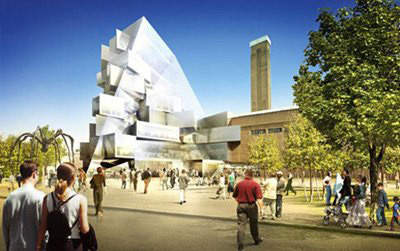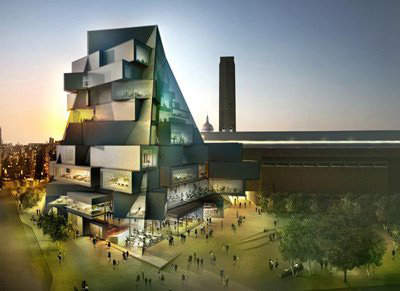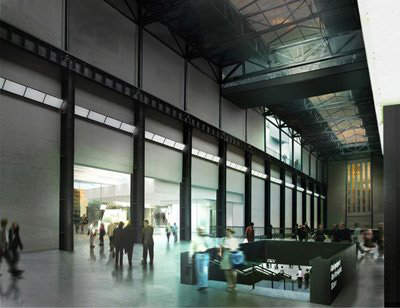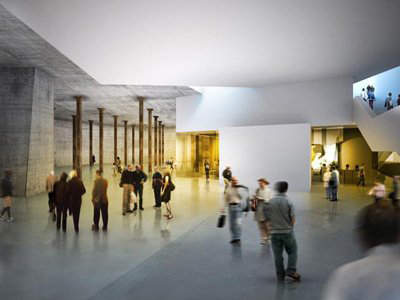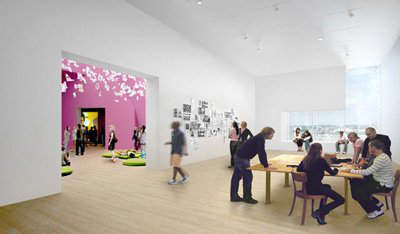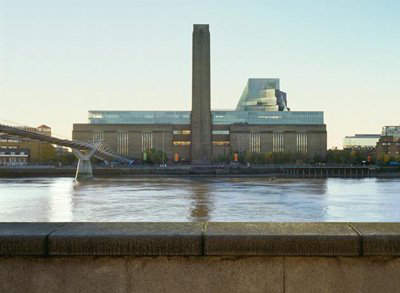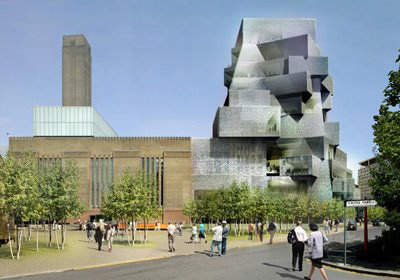In March 2007, the proposed extension of the Tate Modern was given planning approval by Southwark Council. The £260m extension created a giant, fragmented glass pyramid structure that provides an annex to the south-west of the existing building.
The extension was designed by architect Jacques Herzog and Pierre De Meuron who were responsible for the original Tate Modern, which was based on the original structure of the Bankside Power Station.
According to Herzog, the pyramid design of the Tate Modern extension can be interpreted in two ways: as the erosion of a pyramid and, in contrast, as a pyramid in the process of emerging.
A tower climbs up above the brick façade of the existing Tate Modern, changing the skyline of Southwark as seen from St Paul’s and the Millennium Bridge that links the Tate to the City of London.
The new tower is branded as ‘Tate Modern 2’. The 11-storey extension is 65m (200ft) high and expanded the gallery’s space by 60% creating 23,400m of new space. It was executed in two phases with the first phase completed in July 2012. The second phase was completed in 2016. The new Tate Modern extension was opened in June 2016.
It caters for the significant increase in visitor numbers, which is currently five million a year, double the amount predicted when the gallery opened in 2000 (25 million visitors since it opened, yet it was designed for 1.8 million visitors a year). Tate Modern is widely recognised as the most popular museum of modern art in the world.
Ramboll was responsible for providing structural, geotechnical, civil, façade engineering and environmental consultancy services. Swift Brickwork was chosen for the complex masonry project.
Awards and timescale
Herzog & de Meuron Architekten received the Royal Institute of British Architects’ gold medal in February 2007 for work, including their redevelopment of the original Tate Modern, adapted from the former Bankside Power Station.
Herzog & de Meuron was selected from an international shortlist to further develop the building in January 2005. The planning commission granted project approval in March 2009.
Construction work started in January 2010 on part of the site once occupied by the oil storage tanks of the former power station. Approximately £90m was invested in the conversion of the oil tanks of the power station.
Tate Modern expansion facilities
The new tower offers ten new galleries, six cafes and bars, two shops, a range of teaching rooms and a chance for the Tate to show more fine art. There are new kinds of galleries to house works from the Tate’s growing collection, space to show new areas of contemporary visual culture and new galleries for major exhibitions as well as a new performance venue.
The extension also houses new education areas and special areas for Tate members and families. There are also two new public squares on the south and west of the building for public use.
Space utilisation
What was not realised is that a large part of the existing Tate Modern building was disused. Located to the south of the Turbine Hall, the Switch House still features an electricity substation that continues to serve a large area of the city and south London.
EDF Energy, the owner and operator of the electricity substation in Switch House, needs to modernise the equipment there, and this has provided an opportunity to move the plant into a smaller area of the building, freeing up space for Tate Modern expansion to the south.
A new building was therefore developed adjoining the existing building on the footprint of the power station’s former oil tanks.
The London Development Agency (LDA) agreed to contribute £7m in funding to meet the total projected costs of the relocation.
Tate Modern master plan
The master plan for the Tate Modern covers the whole site and proposes a series of new public spaces and routes on all sides of the former power station, within which two new buildings will be set.
The first building, which is located on the site of the disused underground oil tanks, is for Tate’s extension. The potential for a second new building (7,000m²) was also identified in front of the east end of Switch House. This would permit another cultural organisation to move to the Bankside.
New pedestrian routes created a new north-south route or ‘street’ through the building, linking the city to Elephant and Castle (open for at least 12 hours a day). There are also improved public spaces for visitors to enjoy the Bankside environment.
More than 1,350 new trees were planted, and new seating was installed. A new landscaped park surrounding the building, the Bankside Urban Park, is a major project initiated by Tate and Southwark Council and is led by the business improvement district, Better Bankside. This connects new landscaped areas around the gallery to open spaces across Southwark extending towards the Elephant and Castle.
Tate extension design
Level one contains ticketing, orientation and the cloakroom area. There are two performance spaces in the disused oil tanks. One is a flexible rectangular box to show a wide range of performance art, installations, broadcasts, concerts and new media.
The second draws upon the unique qualities of the oil tanks and doubles up as a foyer area. The art space has been created out of the foundations of the existing Switch House.
On level two, visitors approach the newly created south entrance through Tate Square, past the Tate Shop and Tate Café. There is a meeting room and a new art space for themed shows from the Tate collection.
Level three contains a temporary exhibition space to accommodate large exhibitions. There is also an adjacent shop, staff offices and staff meeting place. Level four accommodates four new galleries for the Tate collection. Flexible floor heights adapt to suit works of differing scales.
On level five a bridge connects the original and new buildings. There are galleries and workspaces to try out new ideas and exhibit work from community programmes.
The level six Tower Gallery is used for cutting-edge contemporary art, with a particular focus on innovation.
The level seven ‘Tate Lab’ is for the exploration of contemporary visual culture. There is a viewing zone to provide access to the Tate collection of video art, performances and sound archive. There are also incubation spaces to nurture artists and organisations, sharing knowledge and ideas.
On level eight, the Tate Forum provides the core of a new and ambitious adult learning programme. It has flexible space and a bar. Level nine accommodates a new member’s area and a kitchen. Level ten houses a new restaurant. On level 11, at the top of the building, there is a public terrace.

